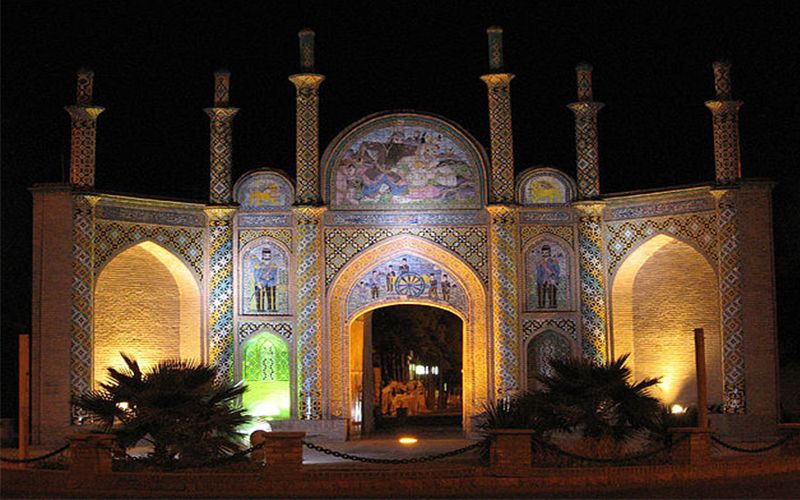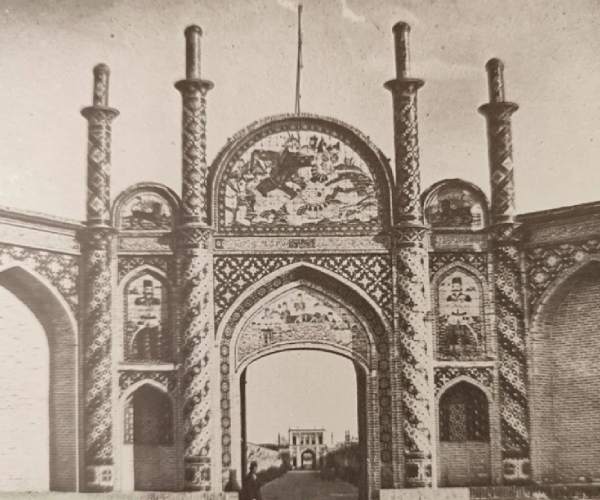
Darvazeh-ye Arg





Arg Gate of Semnan
The Arg Gate, also known as Maidan-e Arg, dates back to the Qajar era and is located at the intersection of Taleghani Street and Sheikh Fazlollah Nouri Street in the heart of Semnan . It was registered as a national heritage site of Iran on June 20, 1979, under the listing number 395. The Arg Gate, also known as Maidan-e Arg, dates back to the Qajar era and is located at the intersection of Taleghani Street and Sheikh Fazlollah Nouri Street in the heart of Semnan. It was registered as a national heritage site of Iran on June 20, 1979, under the listing number 395.
The Arg Gate is one of the last remnants of the old Semnan government citadel from the Qajar era. It served as the northern entrance to the old Arg complex, and was constructed under Bahman Mirza Baha’ al-Dawla, son of Fath-Ali Shah Qajar. An inscription on the gate states that it was completed in 1302 AH (circa 1885 CE) during the reign of Naser al-Din Shah Qajar, under the governorship of Anushirvan Mirza, ruler of Semnan, Damghan, Shahrud, and Bastam. Historical accounts mention a large underground passageway connecting the Arg Gate to the Kalantar’s Mansion (Badgir House). This tunnel was wide enough for two people to walk side by side and was likely used for troop movement and weapons storage. Although most of the original Arg complex was demolished during urban modernization under Reza Shah Pahlavi, the northern gate was spared and remains as a historic and artistic landmark.

The Arg Gate features two symmetrical façades: north and south. The northern façade is the more ornate of the two and is distinguished by its vibrant tilework and decorative minarets. The southern side has two symmetrical rooms on either side of an entry archway, each fronted by small verandas. Two small corridors and a main entrance serve as the original entry and exit point of the Arg. What truly sets the northern façade apart is its colorful seven-color tilework, minarets, and artistic detailing. Unlike traditional mosaic tiles that are painstakingly assembled like a puzzle, these tiles are painted in single pieces, making them faster and cheaper to produce while still offering rich detail and vibrant color. These tiles often depict stories and symbols, giving the gate both decorative and narrative value.
The Arg Gate is not only a functional historical structure but also a work of art. It was built at the command of Naser al-Din Shah Qajar, during his stay in Semnan in 1246 AH (circa 1830 CE) en route to Mashhad. At the time, the Arg had 12 towers and a southern gate, but no northern entrance. The Shah ordered the construction of a northern gate, which was completed in 1263 AH (circa 1847 CE) under the governance of Anushirvan Mirza Zia’ al-Dawla.
The arch and crown of the gate are adorned with vivid scenes from Persian mythology, including battles between Rostam and Sohrab and the White Demon, symbolizing the eternal conflict between good and evil. At both corners of the arch, symmetric images of lions and suns—the ancient Iranian symbol of monarchy—are depicted. The lion holds a sword, and the sun rises behind it, symbolizing power and sovereignty. On either side of the arch are Qajar soldiers in traditional Cossack uniforms, and at the top of the gate, armed Cossack soldiers, military officers, and even a war chariot or cannon are portrayed in vivid tilework. Flanking the gate are niches and stone benches, decorated with glazed brick and geometric tile patterns, likely intended as resting spots for those waiting outside. The main gate door is made of wood, reinforced with brass and steel bolts, adding both strength and decorative detail. The seven ornamental minarets, although non-functional in a religious sense, serve purely aesthetic purposes.
On the interior side of the gate, beautiful tilework and a royal decree mention the gate’s construction by order of Naser al-Din Shah. Two smaller doors on either side lead to rooms with staircases ascending to the roof. Interestingly, the design of this gate bears a strong resemblance to the historic gates of Qazvin and Tehran. The depiction of Cossack soldiers also appears at the main gate of Tehran's Bagh-e Melli, suggesting that these structures were built during the same period by similar artisans.
In Qajar-era Iran, government citadels typically included water reservoirs, public baths, bazaars, currency exchange offices, stables, and government buildings. Unfortunately, none of these elements survive in Semnan’s Arg complex—only the northern gate remains.
With its deep historical roots, Semnan Province offers visitors a rich cultural experience. Thanks to its proximity to Tehran, the city is easily accessible, making it an excellent destination for both local and international travelers. We at Sana Persian Travel sincerely hope to welcome you soon to Iran, and specifically to Semnan Province, where we invite you to experience the beauty and grandeur of the Arg Gate of Semnan—a timeless reminder of Iran’s architectural and cultural heritage. We look forward to hosting you. If you'd like, I can prepare this as a travel brochure, blog post, or museum placard depending on your project. Just let me know the format or audience.
Contact Us
+989054577261